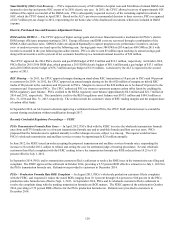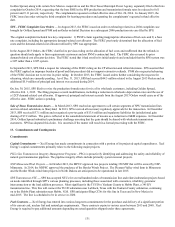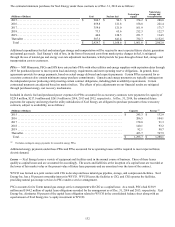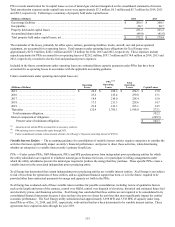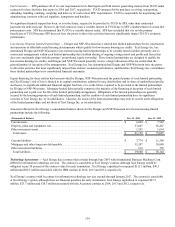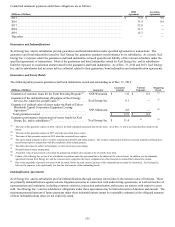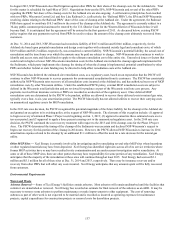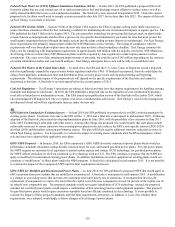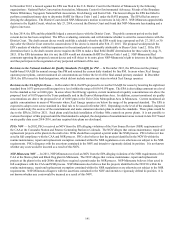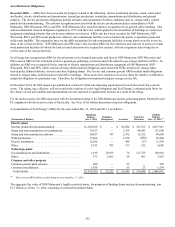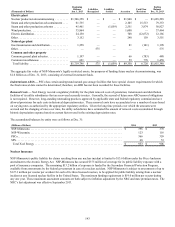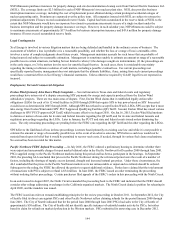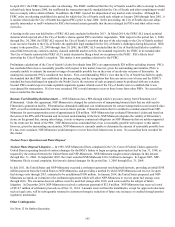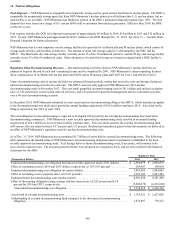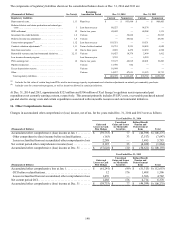Xcel Energy 2014 Annual Report Download - page 156
Download and view the complete annual report
Please find page 156 of the 2014 Xcel Energy annual report below. You can navigate through the pages in the report by either clicking on the pages listed below, or by using the keyword search tool below to find specific information within the annual report.
138
Federal Clean Water Act (CWA) Effluent Limitations Guidelines (ELG) — In June 2013, the EPA published a proposed ELG rule
for power plants that use coal, natural gas, oil or nuclear materials as fuel and discharge treated effluent to surface waters as well as
utility-owned landfills that receive coal combustion residuals. The final rule is now expected in September 2015. Under the current
proposed rule, facilities would need to comply as soon as possible after July 2017, but no later than July 2022. The impact of this rule
on Xcel Energy is uncertain at this time.
Federal CWA Section 316(b) — Section 316(b) of the federal CWA requires the EPA to regulate cooling water intake structures to
assure that these structures reflect the best technology available for minimizing adverse environmental impacts to aquatic species. The
EPA published the final 316(b) rule in August 2014. The rule prescribes technology for protecting fish that get stuck on plant intake
screens (known as impingement) and describes a process for site-specific determinations by each state for sites that must protect the
small aquatic organisms that pass through the intake screens into the plant cooling systems (known as entrainment). For Xcel Energy,
these requirements will primarily impact plants within the NSP-Minnesota service territory. The timing of compliance with the
requirements will vary from plant-to-plant since the new rule does not have a final compliance deadline. Xcel Energy estimates the
likely cost for complying with impingement requirements is approximately $46 million with the majority needed for NSP-Minnesota.
Xcel Energy believes at least three NSP-Minnesota plants could be required by state regulators to make improvements to reduce
entrainment. The exact cost of the entrainment improvements is uncertain, but could be up to $145 million depending on the outcome
of certain entrainment studies and cost-benefit analyses. Xcel Energy anticipates these costs will be fully recoverable in rates.
Federal CWA Waters of the United States Rule — In April 2014, the EPA and the U.S. Army Corps of Engineers issued a proposed
rule that significantly expands the types of water bodies regulated under the CWA. If finalized as proposed, this rule could delay the
siting of new pipelines, transmission lines and distribution lines, increase project costs and expand permitting and reporting
requirements. The ultimate impact of the proposed rule will depend on the specific requirements of the final rule and cannot be
determined at this time. A final rule is not anticipated before the second quarter of 2015.
Coal Ash Regulation — Xcel Energy’s operations are subject to federal and state laws that impose requirements for handling, storage,
treatment and disposal of solid waste. In 2010, the EPA published a proposed rule on the regulation of coal combustion byproducts
(coal ash) as hazardous or nonhazardous waste. The EPA issued a pre-publication version of the final rule in December 2014, which
once promulgated will impose new rules to regulate coal ash as a nonhazardous solid waste. Xcel Energy’s costs for the management
and disposal of coal ash will not significantly increase under the new rule.
Air
GHG Emission Standard for Existing Sources — In June 2014, the EPA published its proposed rule on GHG emission standards for
existing power plants. Comments were due to the EPA on Dec. 1, 2014 and a final rule is anticipated in mid-summer 2015. Following
adoption of the final rule, states must develop implementation plans by June 2016, with the possibility of an extension to June 2017
(June 2018 if submitting a joint plan with other states). Among other things, the proposed rule would require that state plans include
enforceable measures to ensure emissions from existing power plants in the state achieve the EPA’s state-specific interim (2020-2029)
and final (2030 and thereafter) emission performance targets. The plan will likely require additional emission reductions in states in
which Xcel Energy operates. It is not possible to evaluate the impact of existing source standards until the EPA promulgates a final
rule and states have adopted their applicable state plans.
GHG NSPS Proposal — In January 2014, the EPA re-proposed a GHG NSPS for newly constructed power plants which would set
performance standards (maximum carbon dioxide emission rates) for coal- and natural gas-fired power plants. For coal power plants,
the NSPS requires an emissions level equivalent to partial carbon capture and storage (CCS) technology; for gas-fired power plants,
the NSPS reflects emissions levels from combined cycle technology with no CCS. The EPA continues to propose that the NSPS not
apply to modified or reconstructed existing power plants. In addition, installation of control equipment on existing plants would not
constitute a “modification” to those plants under the NSPS program. A final rule is anticipated in mid-summer 2015. It is not possible
to evaluate the impact of the re-proposed NSPS until its final requirements are known.
GHG NSPS for Modified and Reconstructed Power Plants — In June 2014, the EPA published a proposed NSPS that would apply to
GHG emissions from power plants that are modified or reconstructed. A final rule is anticipated in mid-summer 2015. A modification
is a change to an existing source that increases the maximum achievable hourly rate of emissions. A reconstruction involves the
replacement of components at a unit to the extent that the capital cost of the new components exceeds 50 percent of the capital cost of
an entirely new comparable unit. The proposed standards would not require installation of CCS technology. Instead, the proposed
standard for coal-fired power plants would require a combination of best operating practices and equipment upgrades. The proposal
for gas-fired power plants would require emissions standards based on efficient combined cycle technology. It is not possible to
evaluate the impact of these proposed standards until the final requirements are known. In addition, it is not clear whether these
requirements, once adopted, would apply to future changes at Xcel Energy’s power plants.


